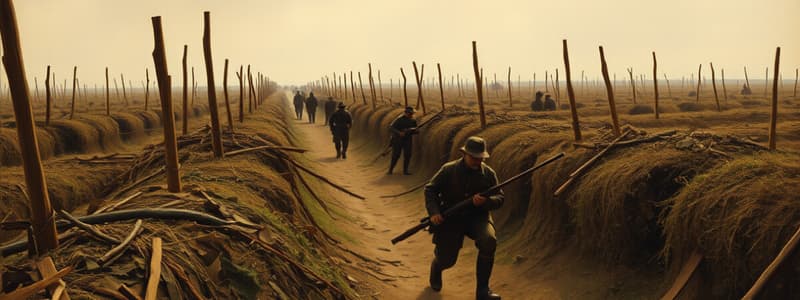Podcast
Questions and Answers
What were the main countries that formed the Allies during the First World War?
What were the main countries that formed the Allies during the First World War?
The main countries included Britain, France, Russia, Italy, and the USA.
What was the initial expectation of the duration of World War I among the combatants?
What was the initial expectation of the duration of World War I among the combatants?
It was widely expected to be a short war, concluded by Christmas 1914.
Which event forced Russia out of World War I?
Which event forced Russia out of World War I?
The Germans captured Poland and forced Russia to exit in December 1917.
What was a major factor in the turning tide for the Allies during the war?
What was a major factor in the turning tide for the Allies during the war?
How did the British navy contribute to the Allies' success by late summer 1918?
How did the British navy contribute to the Allies' success by late summer 1918?
When was the armistice that effectively ended the fighting in World War I signed?
When was the armistice that effectively ended the fighting in World War I signed?
What major incident occurred on the western front that delayed the German advance?
What major incident occurred on the western front that delayed the German advance?
What was the nature of the peace settlement signed at Versailles in 1919?
What was the nature of the peace settlement signed at Versailles in 1919?
What was the significance of the delay experienced by the Germans in reaching Paris?
What was the significance of the delay experienced by the Germans in reaching Paris?
How did the conditions faced by the German troops affect their advance towards Paris?
How did the conditions faced by the German troops affect their advance towards Paris?
Why is the Battle of the Marne considered one of the most decisive battles in modern history?
Why is the Battle of the Marne considered one of the most decisive battles in modern history?
What strategic mistakes did the Russians make in their military strategy on the Eastern Front?
What strategic mistakes did the Russians make in their military strategy on the Eastern Front?
What were the outcomes of the battles of Tannenburg and the Masurian Lakes for Russia?
What were the outcomes of the battles of Tannenburg and the Masurian Lakes for Russia?
What impact did Turkey's entry into the war have on Russia?
What impact did Turkey's entry into the war have on Russia?
What role did the Serbian forces play in the conflict at the end of 1914?
What role did the Serbian forces play in the conflict at the end of 1914?
How did the Western Front evolve by 1915 in terms of military strategy?
How did the Western Front evolve by 1915 in terms of military strategy?
What was the consequence of the expansive casualties suffered by British and German troops during the attack?
What was the consequence of the expansive casualties suffered by British and German troops during the attack?
How did Douglas Haig come to be criticized by historians?
How did Douglas Haig come to be criticized by historians?
What were the estimated casualties for the British, German, and French forces combined?
What were the estimated casualties for the British, German, and French forces combined?
What belief did both British and French generals maintain regarding military tactics despite the high casualties?
What belief did both British and French generals maintain regarding military tactics despite the high casualties?
What change in military approach did Haig eventually adopt toward the end of the war?
What change in military approach did Haig eventually adopt toward the end of the war?
How did the events of the Somme battle affect British politics?
How did the events of the Somme battle affect British politics?
Why did one German officer famously describe the British army as 'lions led by donkeys'?
Why did one German officer famously describe the British army as 'lions led by donkeys'?
What was the extent of the territorial gains made by the Allies during the prolonged attack?
What was the extent of the territorial gains made by the Allies during the prolonged attack?
What were the three primary aims of the Allies' navies during the conflict?
What were the three primary aims of the Allies' navies during the conflict?
How did the British navy achieve success against German naval forces by the end of 1914?
How did the British navy achieve success against German naval forces by the end of 1914?
What significant action did Britain take to enforce its blockade against the Central Powers?
What significant action did Britain take to enforce its blockade against the Central Powers?
What were the German tactics in response to the Allied blockade and why were they implemented?
What were the German tactics in response to the Allied blockade and why were they implemented?
What incident in April 1915 significantly shifted American public opinion regarding the war?
What incident in April 1915 significantly shifted American public opinion regarding the war?
What was the German claim regarding the sinking of the Lusitania?
What was the German claim regarding the sinking of the Lusitania?
How did the events of 1916, particularly the battles at Verdun and the Somme, affect German morale according to Hindenburg?
How did the events of 1916, particularly the battles at Verdun and the Somme, affect German morale according to Hindenburg?
What were the implications of the American casualties from the Lusitania sinking for President Wilson?
What were the implications of the American casualties from the Lusitania sinking for President Wilson?
How did U-boat tactics affect neutral shipping during the conflict?
How did U-boat tactics affect neutral shipping during the conflict?
What key changes did David Lloyd George implement as Prime Minister to support the Allied war effort?
What key changes did David Lloyd George implement as Prime Minister to support the Allied war effort?
In the Eastern Front, what were the outcomes of Brusilov's attacks on the Austrians in June 1916?
In the Eastern Front, what were the outcomes of Brusilov's attacks on the Austrians in June 1916?
What was the purpose of the convoy system introduced during Lloyd George's tenure as Prime Minister?
What was the purpose of the convoy system introduced during Lloyd George's tenure as Prime Minister?
Why were both the British and German navies hesitant to engage in major naval battles during World War I?
Why were both the British and German navies hesitant to engage in major naval battles during World War I?
What critical role did Lloyd George play in the British war cabinet he established?
What critical role did Lloyd George play in the British war cabinet he established?
How did the Austrians respond to Brusilov's attacks before the arrival of German reinforcements?
How did the Austrians respond to Brusilov's attacks before the arrival of German reinforcements?
What did Churchill mean when he said Admiral Jellicoe could have 'lost the war in an afternoon'?
What did Churchill mean when he said Admiral Jellicoe could have 'lost the war in an afternoon'?
Flashcards are hidden until you start studying
Study Notes
First World War Summary
- The opposing alliances in World War 1 were the Allies (Entente) and the Central Powers.
- The Allies included Britain, France, Russia, Italy, Serbia, Belgium, Romania, the USA and Japan.
- The Central Powers included Germany, Austria-Hungary, Turkey and Bulgaria.
- The initial expectation was a short, decisive war but the conflict soon turned into a prolonged stalemate.
- The Germans failed to secure a swift victory over France and trenches were established on the Western Front.
- Eastern Europe saw more movement initially with Russian successes against Austria.
- Germany captured Poland in 1917 forcing Russia out of the war.
- The USA joined the war in 1917 and contributed to weakening Germany.
1914 Western Front
- The German advance was delayed by Belgian resistance, giving the British time to prepare.
- The Germans failed to capture Paris and were driven back to the Aisne by a French counterattack at the Battle of the Marne.
- The Battle of the Marne is significant as it destroyed the German Schlieffen Plan and ended hopes of a quick victory.
1914 Eastern Front
- The Russians mobilized quickly but failed to achieve decisive victories against both Austria and Germany.
- Germany defeated the Russians at Tannenberg and the Masurian Lakes, crippling Russian logistics and morale.
- The entry of Turkey in the war further hampered Russian supply lines.
- Serbia successfully repelled an Austrian invasion, weakening Austrian morale.
1915 Western Front
- The Western Front remained in stalemate despite attempts to break the trench lines.
- The Battle of the Somme was an example of the devastating and ineffective tactics of the time.
- The battle resulted in massive casualties for both sides.
- The introduction of conscription in Britain indicated its commitment to the war.
- Critical public opinion led to the resignation of Prime Minister Asquith in 1916.
David Lloyd George as Prime Minister
- David Lloyd George became British Prime Minister in December 1916.
- Lloyd George played a vital role in the war effort, improving supply lines and introducing new technologies.
- He established a war cabinet to accelerate decision-making and introduced the Ministry of National Service.
1915 Eastern Front
- Brusilov's offensive against Austria in 1916 was a successful Allied effort to divert German attention.
- Romania's invasion of Austria in 1916 was unsuccessful.
- German intervention and the capture of Romanian resources worsened the situation for the Allies.
Naval Warfare
- Naval warfare was expected to be a key battleground but both sides chose to avoid direct confrontation.
- The British strategy relied on blockading the Central Powers and protecting their own supply routes.
- The British successfully destroyed German surface vessels at the Battle of the Falkland Islands, leaving only the main German fleet and Baltic Squadron.
- This strategy proved successful but caused friction with the USA, who was concerned about trade restrictions.
- Germany retaliated with mines and submarine attacks, aiming to disrupt enemy shipping.
- German submarine tactics resulted in the sinking of the Lusitania, which contributed to the USA’s decision to join the war.
- The British responded by developing a convoy system to protect merchant vessels.
Studying That Suits You
Use AI to generate personalized quizzes and flashcards to suit your learning preferences.




